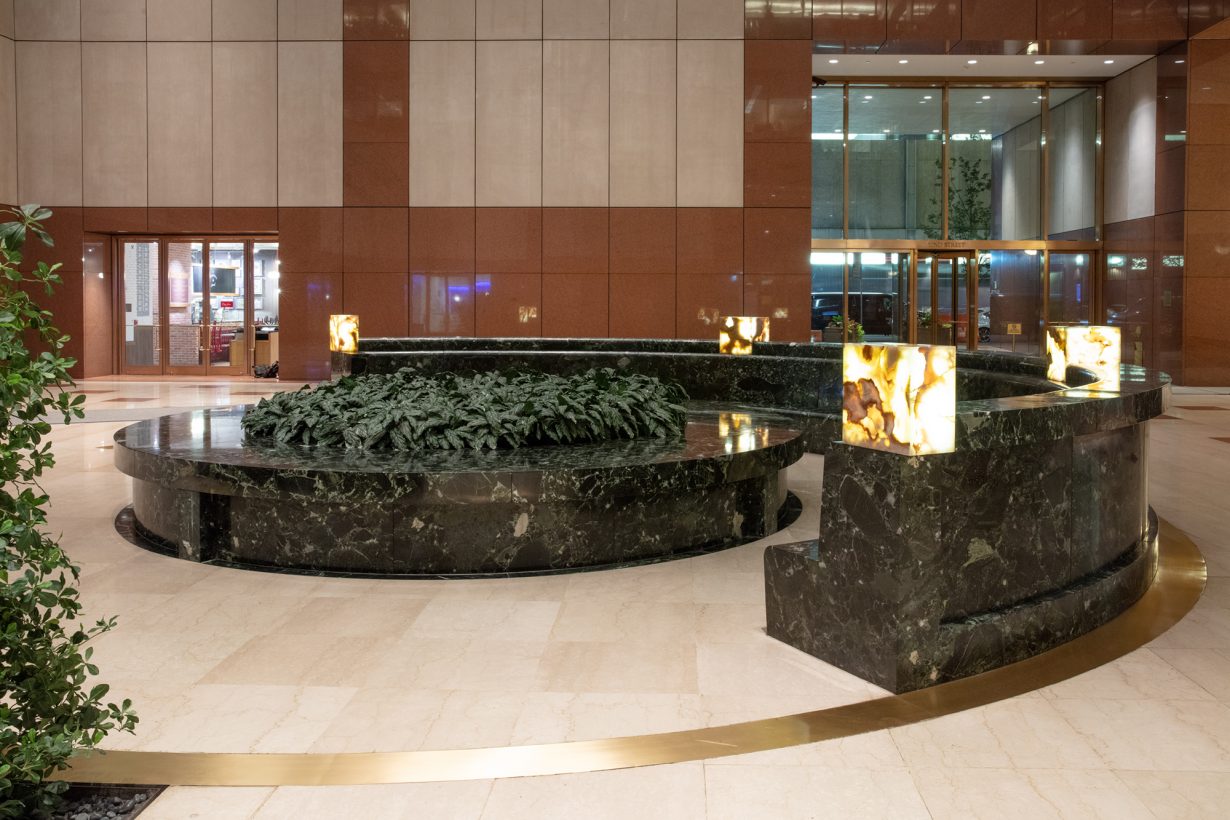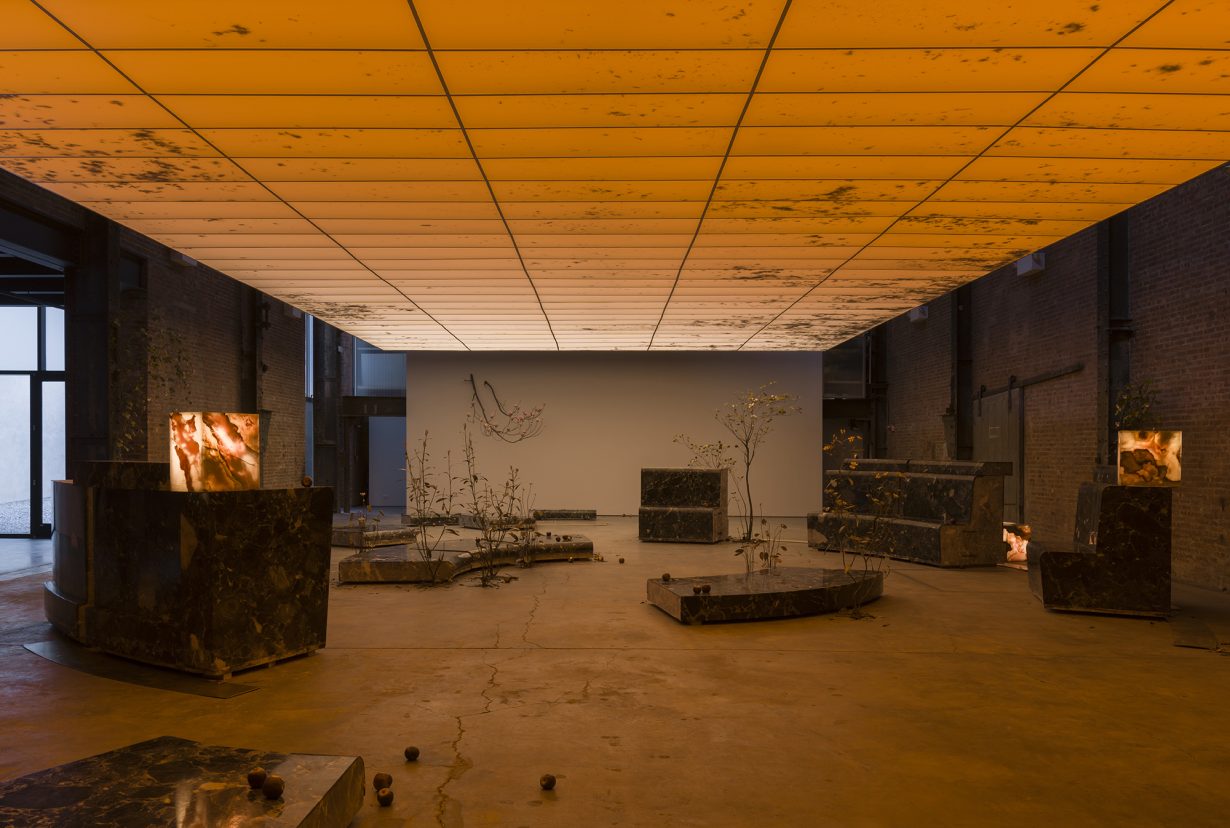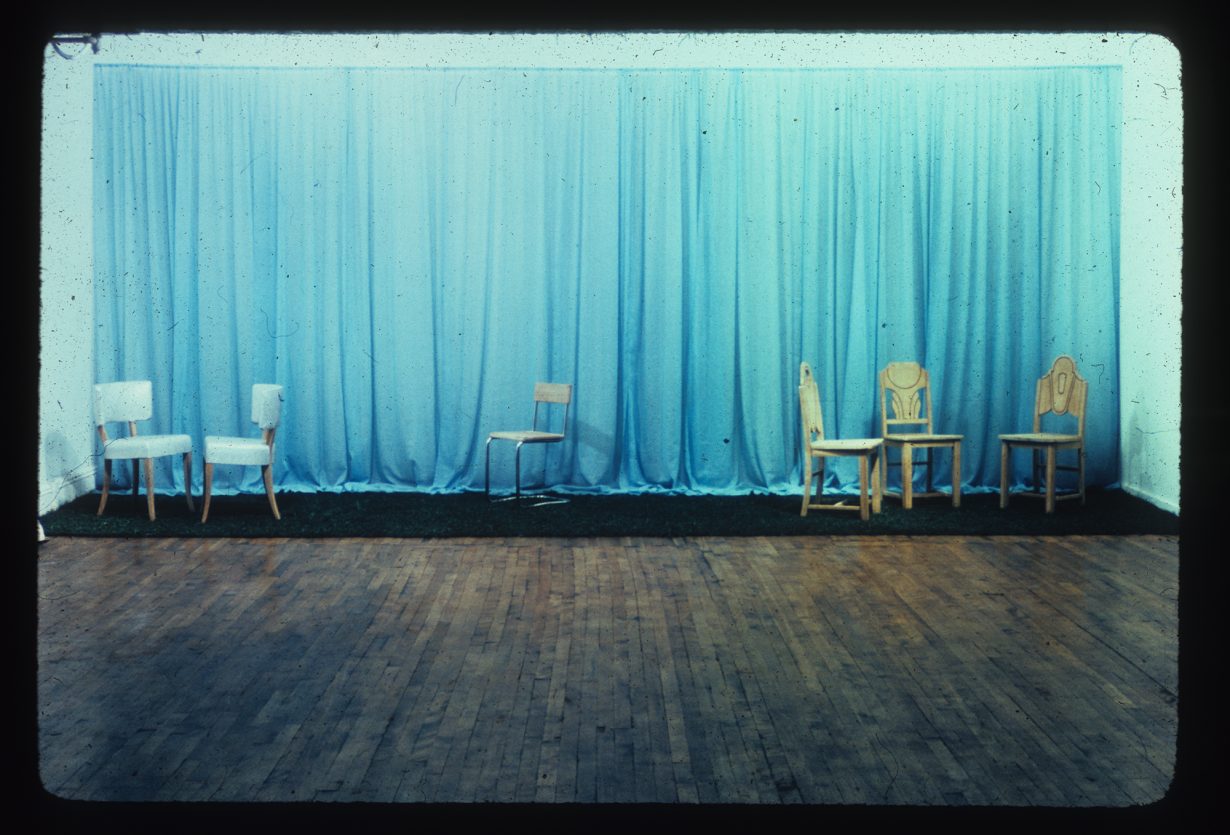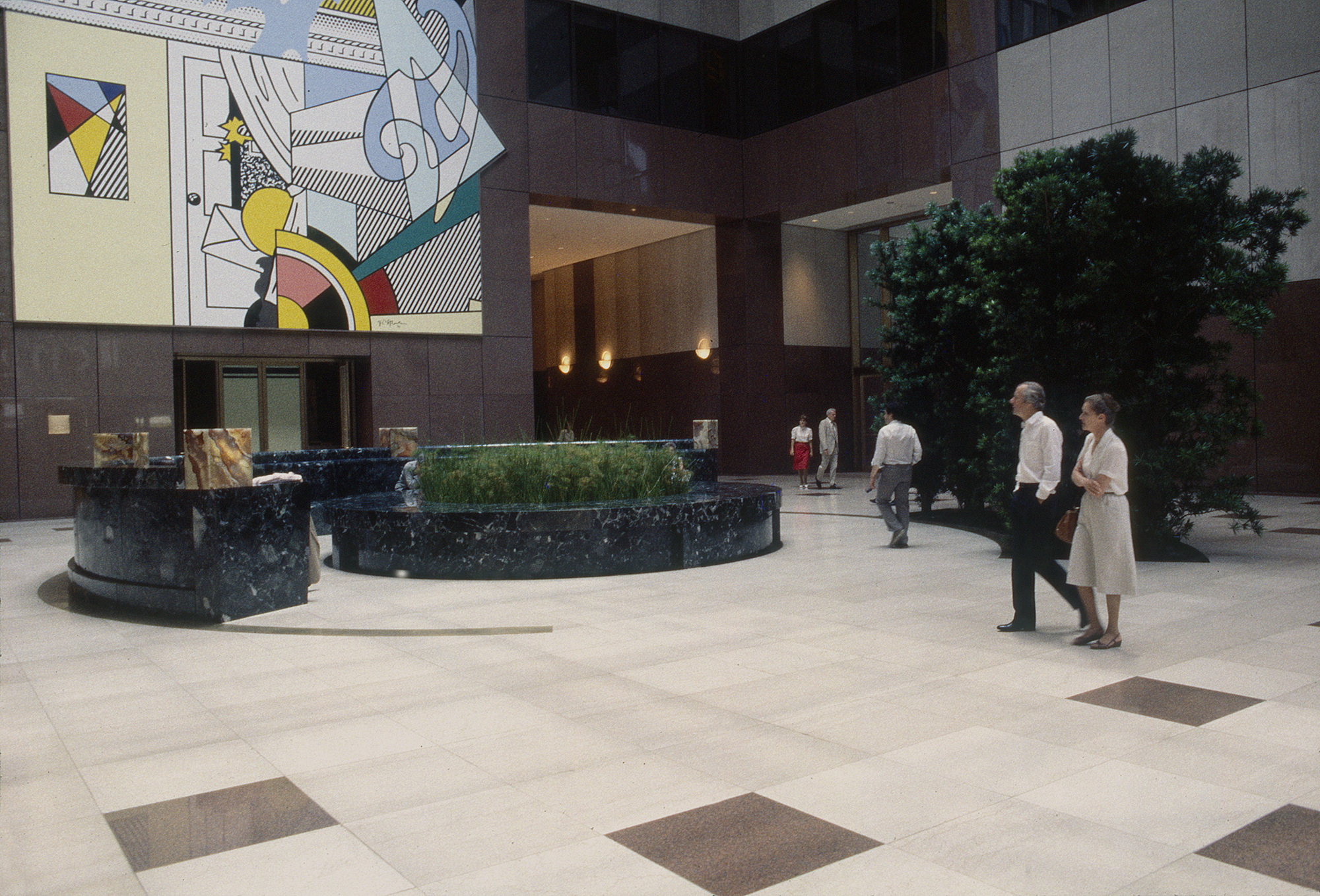The afterlife of Scott Burton’s sculpture, Atrium Furnishment, now on show as part of a larger installation, stands in contrast to a world becoming increasingly hostile by design
A light flickers overhead in SculptureCenter’s main gallery. It comes from the inside of a largescale metal and plexiglass sculpture, resembling a dropped ceiling in a corporate office, that stretches over Álvaro Urbano’s installation TABLEAU VIVANT (2024–25). The flickers occasionally swell into flashes of LED lightning that illuminate, first in amber, then cool white, silhouettes of dead leaves, some swept into piles, others motorised and dancing in circles. The floor is littered with cigarette butts and boasts an array of botanical life – magnolias, morning glories, rhododendrons and more – among which red apples lie, bitten and discarded. When one realises that these flowers and pieces of fruit are in fact hyperreal sculptures fabricated from metal and paint, the Berlin-based artist’s exhibition starts to feel like an approximation of nature – a fantasy, even.
Within the installation, suggestive of a stage set, are several polished stone benches carved from green marble on which visitors can sit and observe this artificial garden. Their edges are rounded, but their disposition is hefty and austere. These architectural segments have been taken from Atrium Furnishment (1986), a decommissioned artwork by the American postminimalist Scott Burton (1939–89). Burton, who was born in Greensboro, Alabama, moved to New York City in 1959. There he began his career as a playwright, critic and performance artist but became better known during the 1980s for designing public sculptures in cities across the United States, Canada and the UK.

These sculptures doubled – or, rather, camouflaged themselves – as functional furniture. In a monograph on the artist, historian David J. Getsy attributes their ‘self-effacing’ and ‘dissembling’ qualities to Burton’s ‘deep understanding of how queer possibility could hide in plain sight’: although the artist was openly gay, he studied and deployed visual codes in his work that rendered it selectively visible. Burton’s sculptures, Getsy argues, behave like people cruising in potentially hostile public spaces. In 1980 Burton wrote that he wanted to make art that ‘place[s] itself not in front of, but around, behind, underneath (literally) the audience – in an operational capacity’. Accordingly, he devoted the final years of his life, which was cut short by HIV-related illness, to cultivating new ways for art to be inclusive and relevant to a wide audience. Getsy calls Burton’s public sculptures ‘demotic’ and ‘all-embracing’. They were not actually meant to register as art, and this, in theory, allowed them to carry out their colloquial objectives.

Since public seating does not strike most people as a form of art, Atrium Furnishment was in practice deprived of the specialised care afforded to objects in museums and private collections. The original 12-metre-wide, multiton verde larissa sculpture comprised a circular table and curved bench, which stood, surrounded by four pink onyx light fixtures, in the lobby of Equitable Life Assurance Company’s corporate headquarters (now the AXA Building) in Midtown Manhattan for over 30 years. The work was slated for demolition during building renovations in 2020 and would have been scrapped had it not been for curator Jeremy Johnston, who has managed the corporation’s substantial collection of Pop and Minimalist art for more than a decade. With the aid of an anonymous sponsor, Johnson rushed in and transported the sculpture piecemeal in September 2020 from the Equitable building into a non-climate-controlled storage facility in Westchester, New York, where the work still sits disassembled on wooden pallets, while Johnston attempts to find an institution willing to receive it as a donation.
In 2023 a few components of Atrium Furnishment were brought out of storage and exhibited in a group show in Manhattan organised by Johnston, which explored permanence vis-à-vis queer histories. Urbano highlights similar thematic and historical concerns with his restaging but does so by taking two discursive sites – the Equitable office building and a popular cruising spot in Central Park called the Ramble – and connecting them by way of Burton’s work and biography. Urbano visualises this connection by interspersing about half of Atrium Furnishment’s original elements with some 1,300 fabricated fruits and flowers modelled after species found in the Ramble. It is common for artists to cite one another, as well as to manipulate and reactivate the work of others in new contexts, and Urbano’s adoption of Burton’s sculpture aligns with the long-established practice of artists using visual quotations to memorialise and mine artistic legacies that have been minimised within dominant historical narratives. Yet TABLEAU VIVANT reveals the complications that are inherent within such citational practices. Urbano’s vision is at odds with Burton’s aim and risks obfuscating the dissembling and demotic spirit of latter’s public art. Whether the late artist’s original intent remains alive and legible in re-presentations of his work will determine, in large part, if it and his legacy have been stewarded or usurped.

Atrium Furnishment may never again be assembled in its original form. For Johnston, who has charged himself with finding a new home for the work, conserving it in accordance with Burton’s intentions has been an ongoing guessing game. If anything, the sculpture’s time away in storage has opened it up to new interpretations. The wall text at SculptureCenter claims that Burton’s work was ‘rescued’ from falling ‘victim to a renovation’ and that Urbano’s installation ‘draws out interiority and desire from Burton’s seemingly impersonal disassembled work’. This reading of Burton’s work isn’t exactly unfounded: in his own criticism, Burton tapped into the expressive potential of seemingly affectless minimalist sculpture, such as Tony Smith’s Die (1962), which he likened to ‘a scream so high it can no longer be heard’. Works by Burton such as Pastoral Chair Tableau (1971–74) featured chairs positioned like people at a party, two groups facing away from a lone chair placed in the centre. However, the rescue narrative personifies Atrium Furnishment at this present time, soliciting the sympathy of viewers due to its ‘uncertain future’. Conceptually, the memorial as a visible, sympathetic artefact stands at odds with the everyday ways in which marginalised groups negotiate visibility, as Burton did regarding his sexuality. Urbano does not out Burton, but by making the latter’s sculpture appear in a gallery setting, he denudes it of its contextual camouflage.

This misalignment between Urbano’s homage and Burton’s intention that the sculptures be used unknowingly by people in public spaces around New York, whether the waterfront plaza in Battery Park City or the street just outside the former Equitable building, speaks to broader issues regarding conservation and efficacy. Immersive environments that mimic atria don’t alter the amenities outside of the art institution that are becoming increasingly hostile by design. All around New York, for instance, one notices seats missing from subways, or spikes and bumps dotting the pavement where the ground once was flat. Amid these changes to the built environment, the afterlife of Atrium Furnishment actualises a conundrum: some sculptures must indeed disappear into the urban landscape in order to perform a civic function, but often stewardship – by private corporations, curators and institutions – becomes necessary to ensure their longevity. Such stewardship, however, risks neutralising the works’ productive ambiguity by treating them primarily as art, which limits the audience they can serve.
Within ten minutes of my entering SculptureCenter, two visitors were admonished for touching Urbano’s metal sculptures. One incident dragged on because the visitor had picked up an apple and carried it several paces, and there was confusion among the staff about where the apple had originally been (on the floor behind the dogwoods) and how it was positioned (bite mark facing up). To be sure, the visitors’ confusion was justified since others were walking in and plopping down on the Burton settee. Given the mercurial whims of the art-viewing demos, preserving any work may prove more difficult than we think.
Álvaro Urbano’s TABLEAU VIVANT installation is on view at SculptureCenter, New York, through 24 March
From the November 2024 issue of ArtReview – get your copy.
